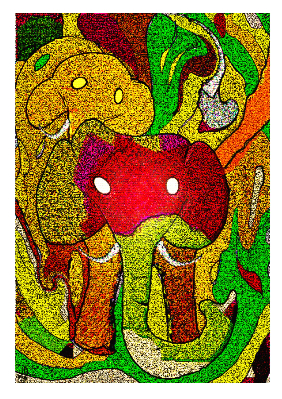Unlocking Creativity: How Scribbling Helps Me Create Art
- Lissia D Fraser
- Aug 25
- 3 min read
Updated: Oct 17
Have you ever sat down, ready to create something magical, only to stare at a blank page with no clue where to begin? Whether you're a writer, musician, or visual artist—or just someone who loves making things for the sheer joy of it—that blank canvas can sometimes feel intimidating.
As an artist myself, I’ve definitely been there. When inspiration is nowhere to be found, I turn to a surprisingly powerful creative tool: scribbling.
The Power of the Scribble
At some point, we’ve all found ourselves doodling—whether it’s during a phone call, a long meeting, or while daydreaming. These casual marks made without much thought can seem random, but they’re far from meaningless. In fact, scribbles often hold the key to unlocking new creative ideas.
Psychologists have long studied the language of scribble. Each line, shape, and curve can reveal hidden thoughts or simply serve as a mental release. Scribbling is also believed to reduce stress and sharpen focus—making it the perfect starting point when you're stuck in a creative rut.
scribble process using tracing paper to isolate and develop shapes
The Psychology Behind Scribbling
Scribbling is often described as a form of non-verbal expression. It bypasses logic and language, tapping directly into the subconscious. According to child psychologists and art therapists, scribbles can offer clues to our inner world—especially in children who haven’t yet developed the vocabulary to describe how they feel, this applies to adults too.

scribble process test- further development of shapes digitally
When we scribble, we allow the mind to relax and wander. This state of mental freedom often leads to new ideas and connections. It’s a little like dreaming while awake. Some researchers even suggest that repetitive doodling and mark-making can increase focus, reduce anxiety, and improve cognitive performance—because the brain is given space to think in the background while the hand is engaged in simple, repetitive motion.
In other words, when you're stuck creatively, the best thing you can do might be to stop trying—and start scribbling.
How I Use Scribbles to Create Original Art Prints
When I'm facing a creative block, I grab a pen and let my hand move freely across the paper. There’s no pressure to make it perfect—just a simple, intuitive process of mark-making.
Over time, these loose sketches become a treasure trove of ideas. Some scribbles spark full scenes in my mind. Others morph into whimsical faces or abstract characters. Once I’ve collected a batch of doodles, the real fun begins.

scribbles used for characters below
When I hit a creative block or just need to loosen up, I pick up a pen or pencil and let my hand move freely across the page. There’s no planning. No expectation. Just instinct.
Some scribbles are loose and abstract, others tighter and more detailed. After a while, patterns start to emerge. I begin to see characters, expressions, or scenes hiding in the chaos—like clouds forming shapes in the sky.
isolated shapes developed from previous scribble above
I rotate the paper, zoom in on interesting shapes, and rework the lines until something recognizable emerges. Then, I bring the best ones into a photo editing program, where I refine them digitally—adding layers of photographic textures, bold colours, and selective filters. This is how many of the art prints you see in my shop are born.
Each piece is a journey that starts with a spontaneous scribble and ends as a carefully crafted visual story.
Why Scribble Art Works
There’s a freedom in scribbling that can’t be matched by structured sketching or planning. It allows your hand to move without judgment and your mind to relax. And often, that’s when the best ideas surface.
For me, it’s not just a method—it’s a mindset. By starting with no expectations, I create space for creativity to flow. And that’s what I think make each of my art work personal and unique.
Image using digitised and Isolated shapes taken from past scribbles
Conclusion: Let Your Hand Lead the Way
Scribbling may seem like a simple act, but it holds a powerful truth: creativity doesn’t always need a plan—it just needs permission. By allowing ourselves to make marks without judgment, we reconnect with the most intuitive, expressive parts of our minds. It’s here, in this playful space, that genuine inspiration often takes shape.
For me, what begins as a scribble transforms into meaningful, original art—pieces that carry the raw energy of imagination and the subtle beauty of spontaneity. It’s a reminder that great art doesn’t have to start with a vision. Sometimes, it just starts with a pen and an open mind.
So the next time you find yourself creatively blocked, try letting go. Pick up a pencil. Scribble. Let your hand lead the way—and you might be surprised at what emerges.















Comments